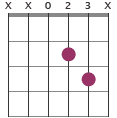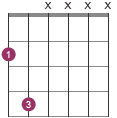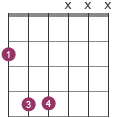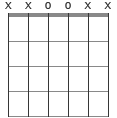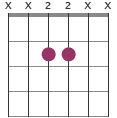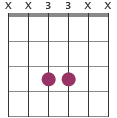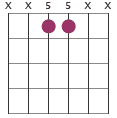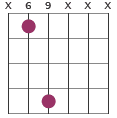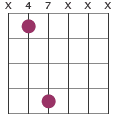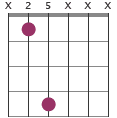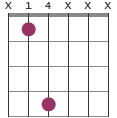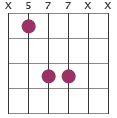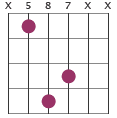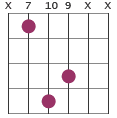Power chords
Power chords consists of the root and the fifth in the scale, which makes it to a two-note chord. Therefore, the power chords are named with a five, such as C5 and D5. The power chords are frequently used in music styles such as rock, heavy metal and punk rock. Yet simple to play, they deliver a full and intensive sound. And the best result is given when you're plugged in with an electric guitar to an amplifier with distortion. Also, using palm muting will bring a cool sound.
5th chords
Sound
Power chord shapes
As you can see in the shape diagrams below, power chords can be played with two or three fingers (shape 2 can also be played by two fingers if the ring finger bar two strings).
Shape 1
Shape 2
Symbols
![]() = Index finger
= Index finger
![]() = middle finger
= middle finger
![]() = ring finger
= ring finger
![]() = little finger
= little finger
![]() = don't strum
= don't strum
Shape 1 includes the root and the fifth while shape 2 uses the root note twice, the second time one octave higher. There is no right or wrong in this case, it's up to your own taste and what sounds best in a specific arrangement.
As with barre chords, the power chords are movable. You can use the same shapes as pictured above all over the fretboard. The only exception is playing a power chord including the fifth string (B-string):
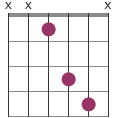
Examples of common 5th chords
The tab picture shows you where to find each power chord on the right fret and root strings according to the notes of the guitar.
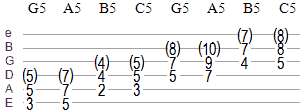
With the help from the diagrams and the tab you should be able to play power chords with any root note you wish.
See more diagrams in power chords chart.
Chord formula
The dominant seventh is built with the formula 1-5 (root and perfect 5th).
Chord construction
C5 x - C - G - x - x - xC#5 x - C# - G# - x - x - x
D5 x - x - D - A - D - x
D#5 x - D# - A# - x - x - x
E5 E - B - x - x - x - x
F5 F - C - x - x - x - x
F#5 F# - C# - x - x - x - x
G5 G - D - x - x - x - x
G#5 G# - D# - x - x - x - x
A5 x - A - E - x - x - x
A#5 A# - F - x - x - x - x
B5 x - B - F# - x - x - x
Guitar versions of the chord
Notes in chord
C5 C - GC sharp 5 C# - G#
D5 D - A
D sharp 5 D# - A#
E5 E - B
F5 F - C
F sharp 5 F# - C#
G5 G - D
G sharp 5 G# D#
A5 A - E
A sharp 5 A# - F
B5 B - F#
The intervals are 1 – 5
Power chord progressions
It's relatively easy to come up with progressions once you have learned the shapes. Just to give a few examples:
G5 - D5 - E5 - C5
G5 - C5 - B5 - D5
D5 - F5 - G5 - A5
A5 - C5 - G5 - F5
B5 - F#5 - G#5 - D#5 - E5 - B5 - F#5
A famous guitar riff that you could play solely with power chords is the intro to "Smoke on the Water":
A5 - C5 - D5 - A5 - C5 - Eb5 - D5 - A5 - C5 - D5 - C5 - A5
Playing examples
Playing examples involving rock chords with tabs and sound:
Combining power chords and bass string:

Combining power chords and single notes:

Download pdf with more and extended playing examples
Power chords – major or minor?
It's neither major nor minor when playing power chords. It may sound strange, but it depends on that there is no third, only the root and the fifth.
| 1 | 2 | 3 | 4 | 5 | 6 | 7 | 8 |
|---|---|---|---|---|---|---|---|
| C | D | E | F | G | A | B | C |
It's actually a great thing is that you don't need to consider major/minor. When progressions include with both major and mainor chords it will for the most times sound good transforming minor chords to power chords as well and treat both major and minor neutrally. C - Am - Dm - G can for example be played as C5 - A5 - D5 - G5. More examples:
(Am - Em7 - C - D) > A5 - E5 - C5 - D5
(Eb - C - G) > Eb5 - C5 - G5
(G - Em - C - G) > G5 - E5 - C5 - D5
(Gm - F - Gm - Bb - C6 - Bb) > G5 - F5 - G5 - Bb5 - C5 - Bb5
A shape sometimes used together with power chords can be seen in the chart below. Some refer the chord below as a "minor power chord", but it's actually a major.
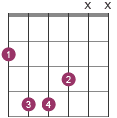
This shape is part of barre chord
and could be useful in a situation there you want some kind of "major sound" between the power chords. If you want a minor sound that goes well with an electric guitar with overdrive, you can sometimes solve it depending on the circumstances. For example, Em could be played as 0220XX instead of 022000.
Not chords at all?
In some reasonings, power chords, are disqualified altogether in definition of chords being more correctly described as intervals. This can be discussed from different perspectives, but more important is that they function as chords. A chord written as A(no3), which is an A triad with the fifth omitted, is the same as A5.
Inverted 5th chords
Sometimes it can be effective to invert the order of tones by making the fifth the bass note. This is common with chords played at the two middle strings and are related with so-called double stops.
G5/D
A5/E
Bb5/F
C5/G
Slash 5th chords
Power chord can be played with an alternative bass note not belonging to the original chord.
E5/D#
D5/C#
C5/B
B5/A#
These shapes are not including the root, instead it's only implied. Another way to look att this chords is as triads without the fifth. For example, E5/D# can also be seen as B/D#(no5) and D5/C# can also be seen as A/C#(no5).
Suggestion of progressions:
E5 - E5/D# - C#5 - B5 - A5
E5 - E5/D# - C#5 - A5 - A5/G# - F#5
G5 - C5/B - C5 - D5/C# - D5
B5 - B5/A# - G#5 - F#5
A5 - F5 - F5/E - F5 - G5 (Dio - "Rainbow in the Dark")
Notice that it may sound better if the second octave tone is omitted (the "Shape 1" is preferred over the "Shape 2" illustrated above), when using an alternative bass note like this. But to be theoretical correct X25XXX should be seen as a C5/B voicing with an implied C root or rather an inverted G5 whereas X255XX is correctly called C5/B. X25XXX is still named C5/B here because it better fits the context.
More power chords with alternative bass note:
D5/F# (G5/F#) : 25XXXX
In a progression:
E5 - D5/F# - G5
E5/G# (A5/G#): 47XXXX
In a progression:
B5 - E5/G# - A5
E as a pedal tone: E5: 079XXX, D5/E: 057XXX, C5/E: 035XXX
In a progression:
E5 - D5/E - C5/E
The concept can be expanded to tone links that goes from bass note to the fifth, such as:
D5 - D5/C# (X47XXX) - E5
This sequence works because that the C# tone goes "halfway" to the fifth in the E5 chord which is a B tone. In other words, a tone sequence of D - C# - B is created but in different voicings. Anyway, it sounds cool (listen to the AC/DC version of "You Shook Me All Night Long" in which the chorus uses the progression G5 - C5 - G5/B - D5).
Another method for slash power chords is to include four notes. When, for example, F5/C could be played as 88 10 10 XX.
"Augmented power chords"
Augmented power chords aren’t a formal name, the formal name in this case would otherwise be aug(no3), but tells what it's all about. An idea to variate the sound and create suspension is to combine a regular power chord with power chord with a raised fifth.
D5
D5(#5)
E5
E5(#5)
The names used for the "aug power chords" may seem illogical, but they are at least consistent.
The idea is to play D5 - D5(#5) or E5 - E5(#5) in a sequence back and forth.
Another way is two-note chords, otherwise with the same principle and goal musically. A sequence could be as the following:
A5 (X02XXX) - Aaug(no3) (X03XXX)
Power chords with open strings
Besides the presented shapes above, power chords can be played in other ways, with non-movable shapes that include open strings. Some examples:
G5: 3X0033
G5/D: XX0033
A5: X055XX
B5: X2440X
C5: X350XX
E5: X79900 / 079900
Chords like these can also be used in other styles, including fingerpicking arrangements.
Power chords with muted strings
Another way to play power chords with an alternative bass note is with a muted string in-between:
C5/G: 3X55XX
D5/A: 5X77XX
E5/B: 7X99XX
An alternate chord shape
A musician often strives for some kind of variation. For open chords you can alternate with sus chords, but this is not the case for the fifth chord. But there is a kind of "sus-chord" that you can use in this context also:
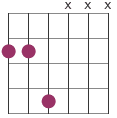
You play this chord shape by holding your index finger over the two lowest strings and release the finger from the second string. When you could alter between a power chord and this alternative (what happen in theory is that we change from tonic, fifth, octave to tonic, fourth, octave).
For pdf-format and additional guidance, see The Power Chords ebook with diagrams, progressions and concepts.
See also Punk chords.



